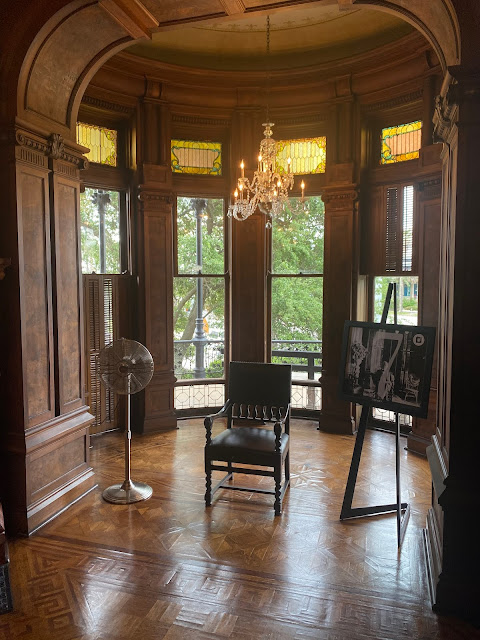I had the opportunity to tour of the Scottish Rite Masonic Temple in Guthrie Oklahoma. The Classical Revival style building has themed rooms influenced by ancient societies, among them are the Assyrians, the Romans and ancient Egyptians that go along with the users philosophies. The building shows 100 year old craftmanship and talents of both American and European artisans.
The massive limestone building occupies over 400,000 square feet and is the largest masonic temple in the united states. It was commissioned in 1910 and the group set out to make "the new Temple as magnificent as art and money can make it" The group was committed to create "the most beautiful Masonic building in the world" The building was completed in 1921. The cost of the building was three million dollars in 1920.
One of three sets massive bronze doors open to the vestibule. There is a revolving door behind the center one. The vestibule provides a transition from the Greek exterior to the Roman Atrium.
The building is adorned (inside and out) with symbols that are significant to the Masons.
The vestibule opens to the Roman style atrium which is nothing short of breath taking in size. Measuring 52' wide and 190' long and 45' tall.
Four types of marble were used on the atrium floors and walls. Tennessee marble makes up the white areas, a reddish-brown Vermont marble is used for contrast while black and grey marble from Italy are used as accents
Corinthian column detail in the Atrium
Detail of the ceiling at each end of the atrium looking up towards the chandelier.
The Pompeii room is off the main atrium. Katharine Davidson used watercolors to design each room. She designed the rugs, the furniture, the drapes and even the light fixtures.
The Pompeii room is said to be modeled after the House of Dolphins which was discovered in Pompeii.
The walls are all coved with freehand friezes on the pilasters and beams. All of the furniture is custom.
The Assyrian room had wood paneled walls with a faux finish to look like stone.
The light fixtures were designed to depict fire pots that were used for heating in Assyrian residences.
Stone sphinxes adorn the fireplace
One of the most beautiful rooms on the tour was the Crystal room. This room was meant for a ladies gathering room. Katharine Davidson was the interior designer for the building. She worked closely with Marion Davidson who designed the plasterwork. They ended up getting married and going on to do the interiors for New York's Rockefeller Center.
The room was based on 18th-century neoclassical Adam style of architecture. Matching custom cabinets sit on each side of the room.
The matching cabinet on the exterior wall contains a wind-up Victrola. The custom rug was woven in Ireland in one piece and shipped to the site by train. It had to be brought in through a window because it wouldn't fit through the doors.
Gold leaf and Czechoslovakian crystal chandeliers adorn the room.
The room also contains a custom designed grand piano by Wurlitzer.
Our next stop was the grand auditorium. We entered the space from back stage. The auditorium has1760 seats.
Classical décor on each side of the stage.
The auditorium has a great organ will over 5,000 pipes.
A smaller Egyptian themed auditorium was next on the tour.
The Egyptian details were painted with egg tempura paint - just as was used in Egypt.
Our tour guide stated that the stars were covered in a metallic glitter that had tarnished before the most recent restoration.
The library was created in the Gothic style.
It also had custom furniture
The library fireplace
Doors in the library
The trim in the library was decorated with Masonic symbols from the 1400's.
Outside the library is the Italian lounge.
View of the Library entrance from the Italian Lounge
The reading room is opposite the Italian Lounge.
The walls are painted with a trompe ole effect to give the illusion of raised panels.
All of the furniture in the reading room was designed for the space except for this cabinet from the 1600's
The Rose Room was also designed as a waiting/gathering space for women, as they were not allowed to participate in the Masonic rituals.
The Rose Room contains a beautiful window that was repurposed from the original Masonic Temple in Guthrie. it is visible at the end of the Atrium on the second floor.
Selfie ?
All of the rooms have beautiful stained glass windows that were sponsored by different patrons.
John Russel Pope, the architect for the building is represented on this window in the Rose room.
This fireplace was located in the office area.
Another view of the office area - great furniture.















